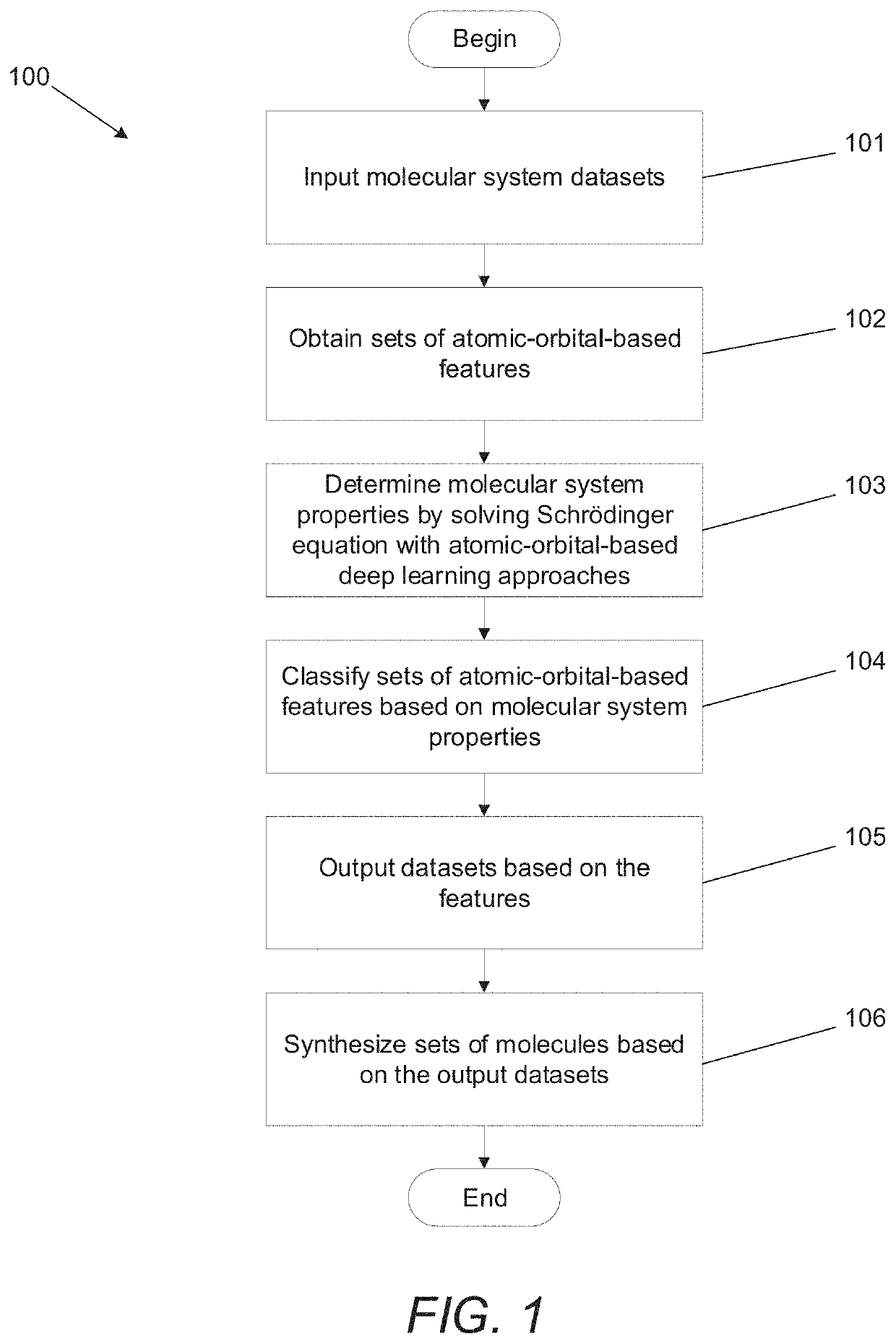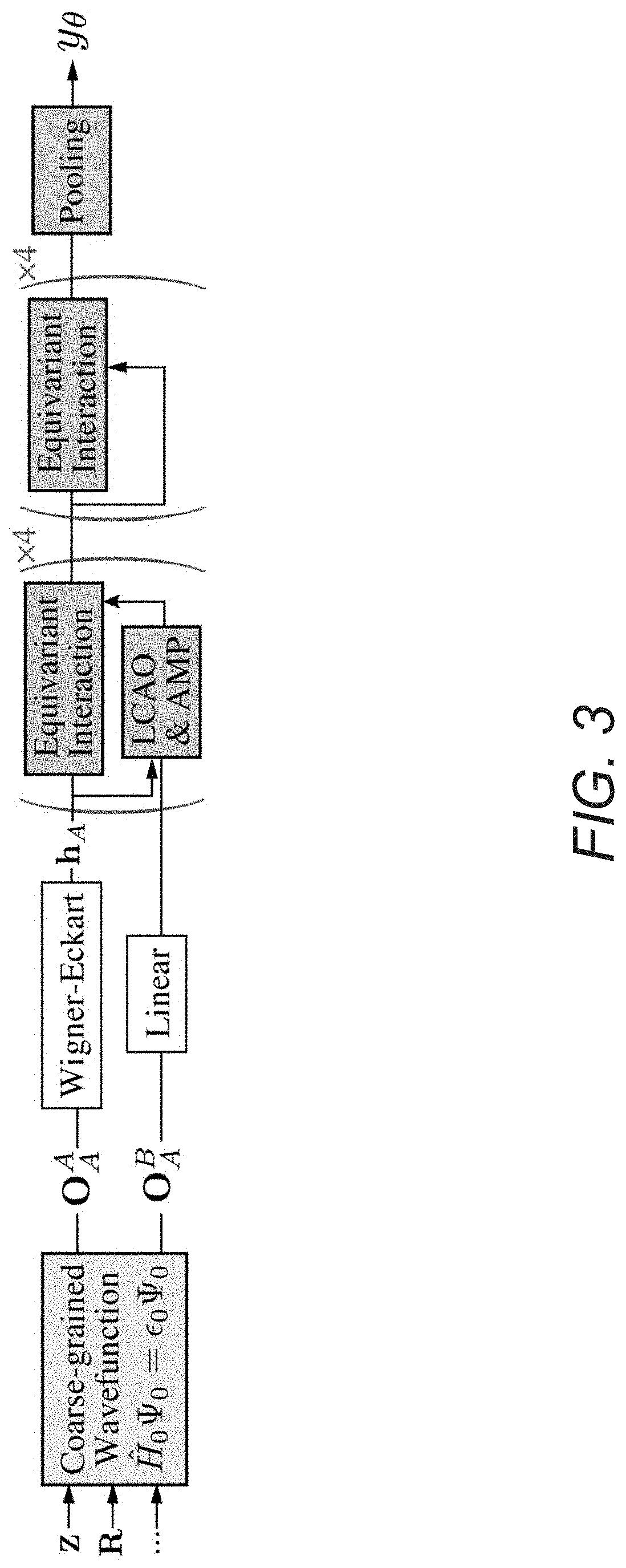Systems and Methods for Determining Molecular Properties with Atomic-Orbital-Based Features
a molecular system and feature technology, applied in the field of systems and methods to design and synthesize molecules based on molecular system properties, can solve the problems of extraordinary computational costs, human-time costs, and consume a sizable fraction of the world's supercomputing resources
- Summary
- Abstract
- Description
- Claims
- Application Information
AI Technical Summary
Benefits of technology
Problems solved by technology
Method used
Image
Examples
example 1
asis to Large Basis HF Energy with OrbNet of SAAO Features
[0183]Many embodiments implement OrbNet to predict the large basis set (i.e., cc-pVTZ) Hartree-Fock (HF) energy of the molecular system from features computed using a cheap minimal-basis (i.e., STO-3G) HF calculation. The regression labels are the difference between the large-basis and the small-basis HF atomization energies, i.e.
ΔEML≈(ETZ−EfreeTZ)−(ESZ−EfreeSZ) (44)
where ETZ and ESZ denote the HF energy obtained from the large and minimal basis set; EfreeTZ and EfreeSZ denote the summation of ground-state free atom energies of the molecule obtained from the large and minimal basis set, respectively.
[0184]The accuracy of the ML predictions is reported in Table 1. Table 1 includes MAE results for learning the STO-3G to predict the cc-pVTZ HF atomization targets, using F, D, and P under the SAAO basis for graph featurization. The model is trained on 6500 QM7b-T molecules, and results are reported from models trained using eith...
examples 2
Energy with OrbNet of SAAO Features
[0185]Many embodiments implement OrbNet to predict the energy of a high-level theory (i.e., DFT with the ωB97X-D range-separated hybrid functional and Def2-TZVP AO basis) of the molecular system from features computed using a low-computational-cost semi-empirical method (i.e., GFN0-xTB). As GFN0-xTB is a non-self-consistent field-based method, features are obtained with a small pre-factor for the O(N3) operation while avoiding the possibility of convergence difficulties that can plague large molecular systems. The regression labels are the difference between the high-level DFT and the GFN0-xTB atomization energies, i.e.
ΔEML≈(EDFT−EfreeDFT)−(ExTB−EfreexTB)−ΔEfit (45)
where ΔEfit is a correction term obtained from a linear fitting on the training set to the atomization energy difference with respect to the number of atoms in the molecule for each element.
[0186]The accuracy of the ML predictions is reported in Table 2. Table 2 includes MAE results for...
example 3
ormation Energy with OrbNet of SAAO Features
[0192]Many embodiments provide the prediction of accurate DFT energies using input features obtained from the GFN1-xTB method. The GFN family of methods can be useful for the simulation of large molecular system (1000s of atoms or more) with time-to-solution for energies and forces on the order of seconds. However, this applicability can be limited by the accuracy of the semi-empirical method, thus creating a natural opportunity for “delta-learning” the difference between the GFN1 and DFT energies on the basis of the GFN1 features. In several embodiments, regression labels can be associated with the difference between high-level DFT and the GFN1-xTB total atomization energies,
EML≈EDFT−EGFN1−ΔEatomsfit (47)
where the last term is the sum of differences for the isolated-atom energies between DFT and GFN1 as determined by a linear model. This approach yields the direct ML prediction of total DFT energies, given the results of a GFN1-xTB calcu...
PUM
 Login to View More
Login to View More Abstract
Description
Claims
Application Information
 Login to View More
Login to View More - R&D
- Intellectual Property
- Life Sciences
- Materials
- Tech Scout
- Unparalleled Data Quality
- Higher Quality Content
- 60% Fewer Hallucinations
Browse by: Latest US Patents, China's latest patents, Technical Efficacy Thesaurus, Application Domain, Technology Topic, Popular Technical Reports.
© 2025 PatSnap. All rights reserved.Legal|Privacy policy|Modern Slavery Act Transparency Statement|Sitemap|About US| Contact US: help@patsnap.com



